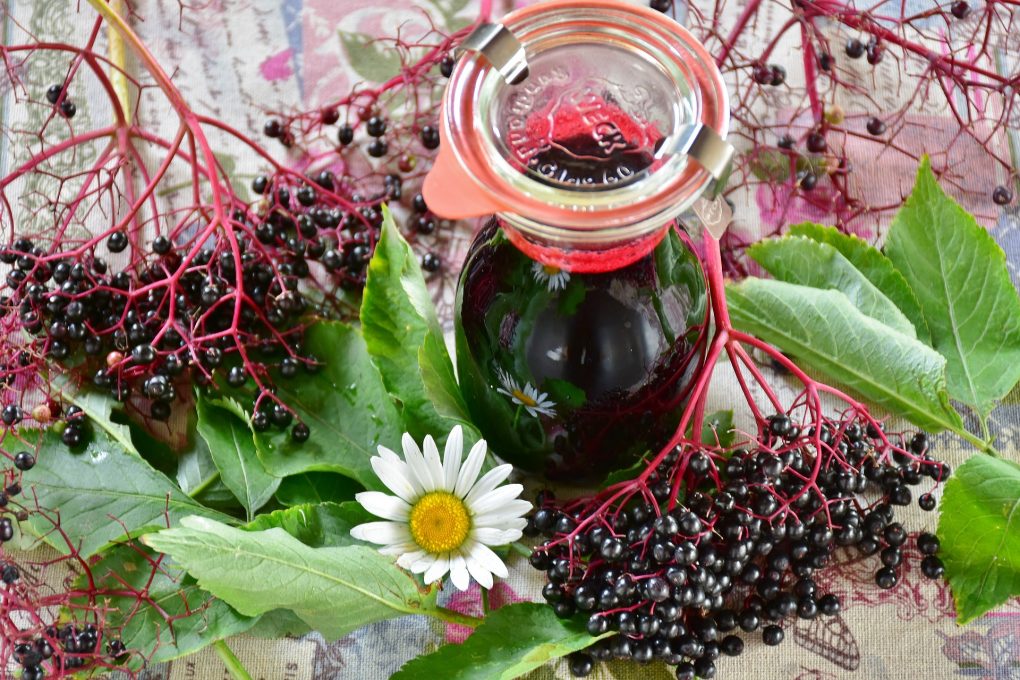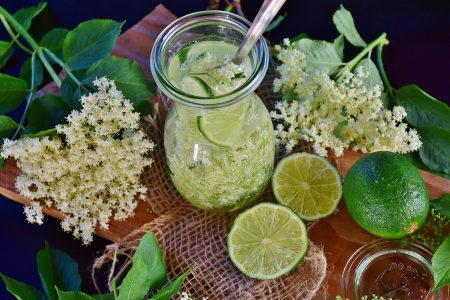
Black elder – health properties
Elderflowers are of a beautiful white shade and have an intense, overpowering smell which I love :). This unusual shrub blooms between May and June. I use elderberry in my kitchen in various ways. I use both the flowers and berries due to their nutritional, health and medicinal properties. For example, I use preparations made from elderberry to treat colds and other diseases involving fever and inflammation. Now is the time to take care of your immune system and pick some elderflowers and later also berries, which can be used to help the body with home-made methods of treatment.
Elderberry is one of the oldest medicinal plants. Scientific research has proven the plant can be used as a treatment in the following cases:
-
Treatment of flu and colds
Thanks to its antibacterial, antiviral and immunomodulatory properties, elderberry can be successfully used to treat colds and flu. Both fruits and flowers exhibit diaphoretic properties. Elderberry blossom extract has moderate anti-inflammatory properties.
-
Treatment of upper respiratory tract infections
Elder blossom infusions can be used as rinses in case of angina, in inflammation of the mouth and throat. The preparations obtained from black elder also have an expectorant effect. The effect is caused, among others, by triterpenes, which irritate the nerve endings, causing increased production and secretion of watery mucus in the airways and as a result a coughing reflex. On the other hand, flavonoids present in black elder juice cause bronchospasm and facilitate expectoration.
-
Treatment of urinary tract infections
As I’ve mentioned earlier, elderberry has antibacterial properties. For this reason, elderberry preparations can be successfully used to treat urinary tract infections. Such preparations increase diuresis. In addition, elderberry flavonoids act on the walls of the kidney tubules, thus hindering the resorption that occurs in them. Elderberry juice is also a good source of vitamin C, which facilitates the fight against infection.
-
Normalization of glucose level
The studies carried out so far have shown elderflowers extract significantly increases glucose uptake, its oxidation, and gluconeogenesis. Studies performed on an animal model have also shown that elderberry can increase insulin secretion.
-
Lowering cholesterol
Research led by Murkovic has shown that elderberry juice can lower both total and LDL cholesterol (“bad” cholesterol), and thus reduce the risk of heart disease.
-
Prevention of civilization diseases
Elderberry fruit and flowers, thanks to their antioxidant properties, are a potentially valuable tool in the prevention of civilization diseases, such as cancer, cardiovascular and neurodegenerative diseases.
-
Improving the appearance of the skin
Elderberry improves blood circulation of the skin and thus benefits its condition. It smoothes wrinkles, whitens freckles, and soothes sunburn. Elderberry flowers are the perfect ingredient for a face mask that brightens discoloration. It is also efficient in the fight against cellulite.
As you can see, elderberry can be a cure for many ailments, but it can be toxic if used improperly. You must remember that early flowers and immature fruits contain sambunigrin – a compound with a potential toxic effect that causes irritation of the digestive tract, diarrhea, and vomiting. It is enough, however, to subject it to heat treatment or to dry it, and the danger will disappear.
Culinary uses
Elderberry is a good source of flavonoids, anthocyanins, triterpenes, sterols, and vitamins. For this reason, I often use both elderberry fruit and flowers in my kitchen. They have a wide range of applications, e.g. I make juices, jams, marmalades, jellies, and desserts. I use the flowers to prepare syrups, drinks or tea.
I encourage you to use black elder for cooking and to prepare home-made treatment. Elderberry preparations taste great, are rich in natural nutrients, and show a number of beneficial pro-health activities.
References:
- Abuja PM, Murkovic M, Pfannhauser W. Antioxidant and prooxidant activities of elderberry (Sambucus nigra) extract in low-density lipoprotein oxidation. J Agric Food Chem. 1998, 46: 4091-6.
- Gray AAM, Abdel-Wahab Y YH, Flatt PPR. The traditional plant treatment, Sambucus nigra (elder), exhibits insulin-like and insulin-releasing actions in vitro. J Nutr, 2000, 130: 15-20.
- Murkovic M, Abuja PM, Bergmann AR, Zirngast A, Adam U, Winklhofer-Roob BM, Toplak H. Effects of elderberry juice on fasting and post-prandial serum lipids and low-density lipoprotein oxidation in healthy volunteers: a randomized, double-blind, placebo-controlled study. Eur J Clin Nutr. 2004, 58: 244-9.
- Ulbricht C, Basch E, Cheung L, Goldberg H, Hammerness P, Isaac R, Khalsa KP, Romm A, Rychlik I, Varghese M, Weissner W, Windsor RC, Wortley J. An evidence-based systematic review of elderberry and elderflower (Sambucus nigra) by the Natural Standard Research Collaboration. J Diet Suppl. 2014, 11: 80-120.










Comments No Comments
Join the discussion…